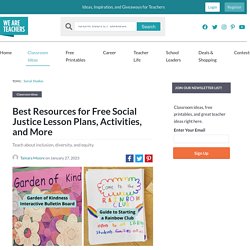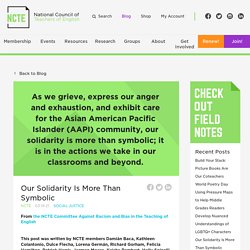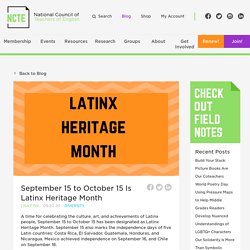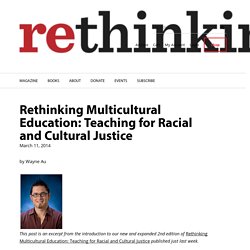

Youtube. Youtube. Five Steps to Address Anti-Blackness: Black Immigrant Literacies. Learning for Justice. 22 Free Resources for Social Justice Lesson Plans. With no federal standards for the topic in place, teachers are left to their own devices for creating or finding social justice lesson plans.

Our country’s history is rich with resistance, organizing, and civil rights campaigning—but for many teachers, these movements seem new. If you want to guide your students through conversations about inclusion, diversity, and equity, it’s important to both teach the history and build upon the work of the countless people who contributed to social justice movements throughout the years. From habeus corpus for Native Americans, to women’s suffrage, to civil rights, none of these freedoms were granted without collective organizing. Unfortunately, many of these stories are invisible.
But it doesn’t have to be this way. Make 2019 the year you stretch yourself. Take a deep dive with these curriculum planning resources: 1. We love this website from the Southern Poverty Law Center. 2. You might not think about poetry when you think of social justice. 4. 22 Free Resources for Social Justice Lesson Plans. One Survivor Remembers. Social Studies, Literacy, and Social Justice. Our Solidarity Is More Than Symbolic. From the NCTE Committee Against Racism and Bias in the Teaching of English This post was written by NCTE members Damián Baca, Kathleen Colantonio, Dulce Flecha, Lorena Germán, Richard Gorham, Felicia Hamilton, Patrick Harris, Jazmen Moore, Keisha Rembert, Holly Spinelli, Jineyda Tapia.

All are members of the NCTE Committee Against Racism and Bias in the Teaching of English. Yet again, we find ourselves collectively mourning loss as a result of hate and desired power. As we grieve, express our anger and exhaustion, and exhibit care for the Asian American Pacific Islander (AAPI) community, our solidarity is more than symbolic; it is in the actions we take in our classrooms and beyond. Since the onset of COVID-19 and its inflammatory and racist framing, the AAPI community has seen increased levels of violence recently, culminating in the deaths of six women of Asian descent. Here are some actions we encourage all ELA educators to take: Be deliberate with your language. September 15 to October 15 Is Latinx Heritage Month. A time for celebrating the culture, art, and achievements of Latinx people, September 15 to October 15 has been designated as Latinx Heritage Month.

Teaching Hard History: Grades K-5. Critical content students must know to understand the historical significance of slavery.

Essential Knowledges 1–10 are designed for K–2 students, and Essential Knowledges 11–20 are designed for students in grades 3–5. Click on each Essential Knowledge to see what students should know and how you can teach it. Grades K-2 Essential Knowledge 1 Students should be encouraged to think and talk about the meaning of freedom. Essential Knowledge 2 Students should know that slavery is when a person owns another person as property. Essential Knowledge 3 Students should know that enslaved Indigenous people and Africans came from nations with diverse cultures and traditions and that they continued many of these traditions while enslaved. Essential Knowledge 4 Students should know that enslaved people had families that could be split up at any time. Why Children Need to See Themselves in Books. Youtube. Rethinking Multicultural Education: Teaching for Racial and Cultural Justice - Rethinking Schools. By Wayne Au This post is an excerpt from the introduction to our new and expanded 2nd edition of Rethinking Multicultural Education: Teaching for Racial and Cultural Justice published just last week.

Rethinking Multicultural Education: Teaching for Racial and Cultural Justice, second edition, has been a long time coming. Over its almost 30 years of existence, Rethinking Schools has published more than 200 articles that dealt explicitly with issues of race and culture. Even though Rethinking Schools has always kept racial and cultural justice amongst our main focal points, until the first edition of Rethinking Multicultural Education in 2009, we had never published a book that specifically focused on race and culture in education in their own right.
7 Ways to Support Diversity in the Classroom [With Examples] Why do children go to school?
![7 Ways to Support Diversity in the Classroom [With Examples]](http://cdn.pearltrees.com/s/pic/th/diversity-classroom-examples-238421839)
Most people would say it’s to learn the three R’s: reading, writing and ‘rithmetic. But a school culture that promotes diversity in the classroom teaches students something that’s more important: how to live and work in a society where every individual is unique.In an increasingly fragmented society, the ability to connect with peers, coworkers and neighbours with diverse backgrounds and abilities is invaluable. Diversity improves critical-thinking skills, builds empathy and encourages students to think differently.If you want to tackle the issue of diversity in the classroom for your school, then this post is for you.
We’ll cover:Plus, we've put together a condensed list of the seven ways you can champion diversity in you school, available as a free download you can print for your desk! What is diversity in the classroom? Diversity is everything that makes people different from each other. Why is diversity in the classroom important? 1. 2. 3. 4. 5. 6. Embracing Diversity to Humanize the Classroom Environment.